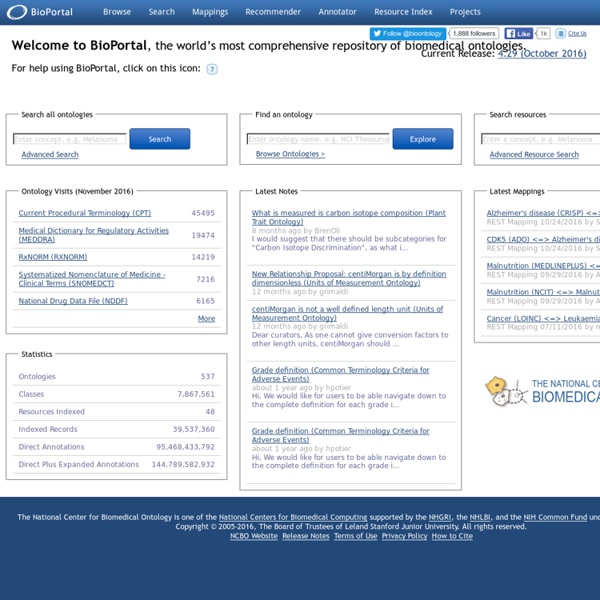



RDF Current Status This page summarizes the relationships among specifications, whether they are finished standards or drafts. Below, each title links to the most recent version of a document. Completed Work W3C Recommendations have been reviewed by W3C Members, by software developers, and by other W3C groups and interested parties, and are endorsed by the Director as Web Standards. Group Notes are not standards and do not have the same level of W3C endorsement. Standards Group Notes Drafts Below are draft documents: Last Call Drafts, other Working Drafts . Last Call Drafts Other Working Drafts
UMLS Terminology Services -- Home Allie: Abbreviation / Long Form Search Top untitled User Page - sbgn.org SBGN study guide Visit the Documents section for: various examples (to get a better idea of what an actual map looks like) some tutorials (very accessible, but not always up-to-date) publications about SBGN (a good start for a brief historical overview) detailed technical specifications (the ultimate reference documents, most up-to-date, but a steep learning curve for beginners) some Frequently Asked Questions Please also check the SBGN PD User Manual when you are ready to draw your own maps. Quick overview The Systems Biology Graphical Notation comprises three complementary languages suited to represent different types of pathways. Process Descriptions (PD) is a language that permits the description of the processes (e.g. biochemical reactions) taking place in a biological system. Entity Relationships (ER) is a language that permits the description of all the relations involving the entities of a biological system. Language reference cards SBGN Bricks dictionary Getting started User Manual
Open Geiger Project LodLive - browsing the Web of Data Data | 1000 Genomes Sample lists and sequencing progress A summary of sequencing done for each of the three pilot projects is available here. The list of samples and allocations is provided in a spreadsheet. Variant Calls Our variant calls are always released in vcf format. Alignments The main project alignments are available in BAM format. Raw sequence files The main project raw sequence data is available in fastq format. Download data The sequence and alignment data generated by the 1000genomes project is made available as quickly as possible via our mirrored ftp sites. EBI FTP: NCBI FTP: Users in the Americas should use the NCBI ftp site and users in Europe and the rest of the world should use the EBI ftp site The data is also available via an Aspera server from both sites. The plugin should automatically start when you visit either the EBI Aspera site or the NCBI Aspera site. An example command line for ascp looks like:
how to do it in Excel One common piece of feedback I get after presenting on the topic of data visualization goes something like this: Wow, that was super useful. I'm never going to use pie charts again. But when it comes to the graphs, how do you actually make them look like that? I'm not Excel-savvy...help! Pretty much everything I do is in Excel. The following example may look familiar; it's from the FlowingData Challenge earlier this year (original blog post here). The full Excel file can be downloaded here. What you require most to get from Excel's original graph to the one you actually are proud to present is patience and time.
DBpedia CCSB Interactome Database Preliminary Human Binary Interactome Datasets Available 1. 13,944 unpublished binary protein-protein interactions (HI-II-11)2. Human ORF collection for binary interaction screening here3. Binary protein-protein interactions from test search space here H uman interactome mapping is the flagship project of CCSB. Viruses intrinsically depend on their host cell during the course of infection and can elicit pathological phenotypes similar to those arising from mutations (Gulbahce et al PLoS Comput Biol 2012). Plants have unique features that evolved in response to environmental and ecological challenges. Yeast Interactome version 1 (CCSB-YI1) contains high-quality yeast two-hybrid protein-protein interactions for S. cerevisiae. Fragmentome: Many protein-protein interactions are mediated through independently folding modular domains.
悲観的時代に楽天家でいるために 編集部注:ゲストライターのDavid Kirkpatrickは、『フェイスブック 若き天才の野望』の著者であり、11月13~15日にアリゾナで開催されるTechonomyカンファレンスの主催者である。 殆どのTechCrunch読者にとって、テクノロジーが世界を変えつつあることは衆知の事実だ。不幸にも、世の中にはそれを理解していない人が驚くほどたくさんいる。 テクノロジーの持つ膨大な問題解決能力を信じる者にとって、今はワクワクすると同時にイライラする時だ。 こうしたテクノロジーの力を得た数十億の途上国の人々が、二流状態に満足することはない。 さらに悪いことに、世界には、国際問題に対する新しいテクノロジー主導の解決法を理解できるリーダーが十分に存在していない。 複雑さに輪をかけているのは、地理的不均衡の増大だ。 こうした状況にも関わらず、大きな楽観材料がある。 事実上世界で最も成長の速い資源は、計算能力とストレージである。 現在世界をとりまく根強い悲観論の主たる原因は、既存の資源が人間の要求を満たすことができないこてへの恐怖である。 テクノロジー駆動の発展により、国際経済格差は急速に縮まりつつある。 テクノロジー楽天家なら、気候変動、文化的誤解、食糧不足、住宅不足、旧式の輸送手段、持続不可能なエネルギー源への依存等、われわれの持つ深刻な課題に対して、テクノロジーが貢献する方法を数多く見出すことができる。 これからの変革は、ボトムアップ主導になる可能性が高い。 テクノロジーに基づく発展で、最も心を躍らされるのは、それがゼロサムでないことだ。 いくら楽観論があるとはいえ、テクノロジーは万能薬ではない。 しかし、テクノロジーの未来を信じるわれわれがより効果的に団結し、共に理解を深めてその膨大な影響力を活用すれば、世界にとって素晴らしい日々が待っている。 [原文へ] (翻訳:Nob Takahashi)
Talks by W3C Speakers Many in the W3C community — including staff, chairs, and Member representatives — present W3C work at conferences and other events. Below you will find a list some of the talks. All material is copyright of the author, except where otherwise noted. Listing is based on the following search constraints: Possible presentation dates: past few months and upcomingTechnology area: Semantic Web February 2014 2014-02-14 (14 FEB)2014-02-20 (20 FEB)Abstract: Data Activity Lead, Phil Archer, assesses the state of Linked Data in 2014, challenging some of the assumptions about where and how it is used, and setting out W3C's plans for the future development of data on the Web. March 2014
American Biotechnologist Much-needed tool for neuroscience emerges after years of work :: Posted by American Biotechnologist on 04-24-2014 Nearly a decade ago, the era of optogenetics was ushered in with the development of channelrhodopsins, light-activated ion channels that can, with the flick of a switch, instantaneously turn on neurons in which they are genetically expressed. The new structurally engineered channel at last gives neuroscientists the tools to both activate and inactivate neurons in deep brain structures using dim pulses of externally projected light. First discovered in unicellular green algae in 2002, channelrhodopsins function as photoreceptors that guide the microorganisms’ movements in response to light. Read more… Advice from a Nobel Prize Laureate :: Posted by American Biotechnologist on 04-23-2014 Want to become a Nobel Prize winner? Don’t listen to anybodyDon’t think about “Big” ideasYour supervisor is decrepit and old…forget about his advice!